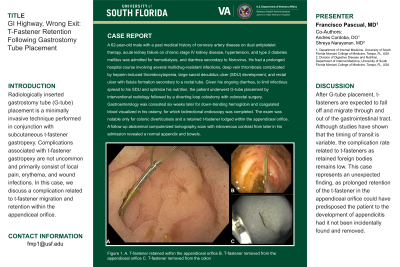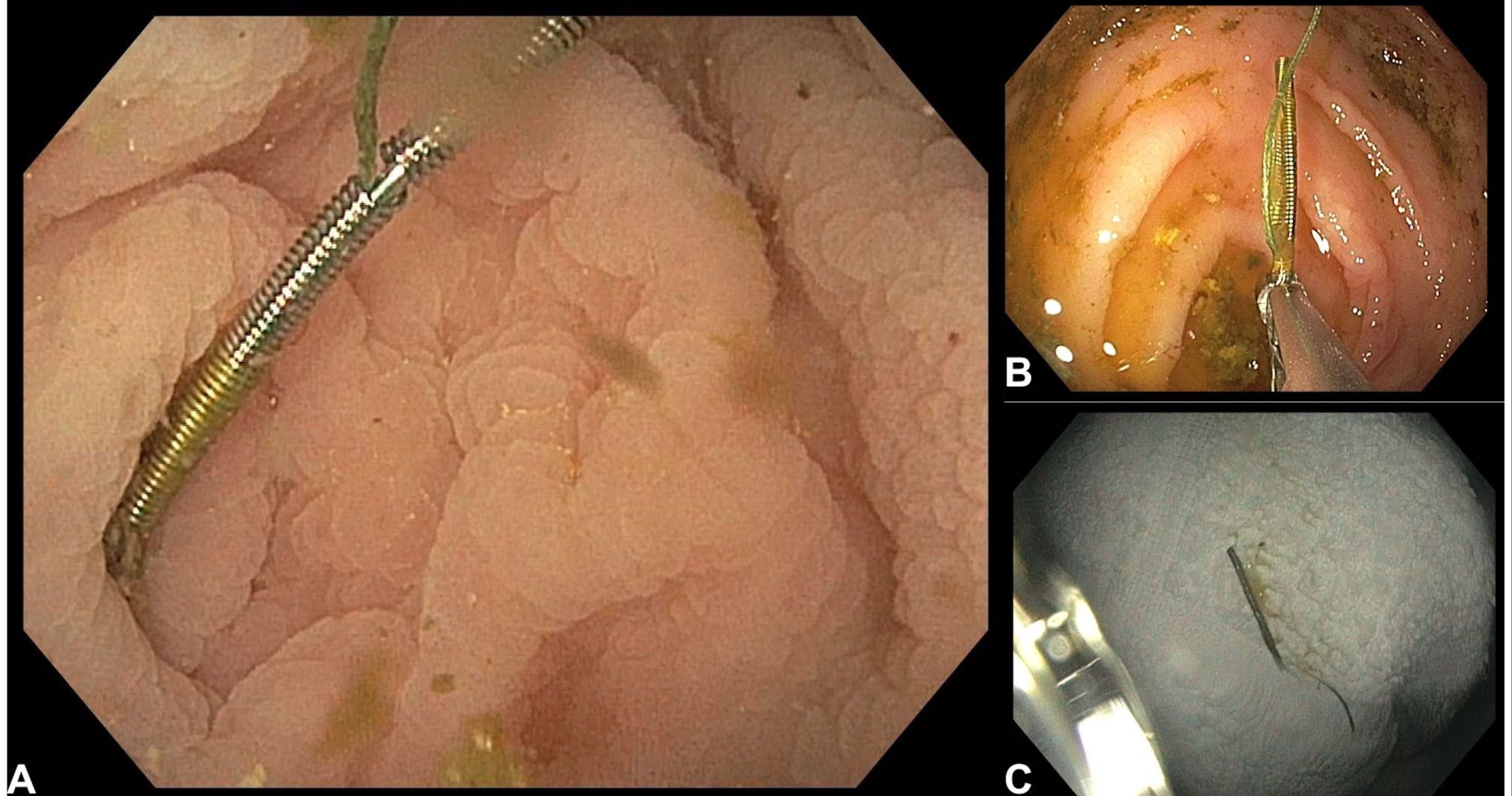Sunday Poster Session
Category: Colon
P0329 - GI Highway, Wrong Exit: T-Fastener Retention Following Gastrostomy Tube Placement
Sunday, October 27, 2024
3:30 PM - 7:00 PM ET
Location: Exhibit Hall E

Has Audio
.jpg)
Francisco M. Pascual, MD
University of South Florida Health
Tampa, FL
Presenting Author(s)
Award: Presidential Poster Award
Francisco M. Pascual, MD1, Andres Cordoba, DO2, Shreya Narayanan, MD2
1University of South Florida Health, Tampa, FL; 2University of South Florida, Tampa, FL
Introduction: Radiologically inserted gastrostomy tube (G-tube) placement is a minimally invasive technique performed in conjunction with subcutaneous t-fastener gastropexy. Complications associated with t-fastener gastropexy are not uncommon and primarily consist of local pain, erythema, and wound infections. In this case, we discuss a complication related to t-fastener migration and retention within the appendiceal orifice.
Case Description/Methods: A 62-year-old male with a past medical history of coronary artery disease on dual antiplatelet therapy, acute kidney failure on chronic stage IV kidney disease, hypertension, and type 2 diabetes mellitus was admitted for hemodialysis, and diarrhea secondary to Norovirus. He had a prolonged hospital course involving several multidrug-resistant infections, deep vein thrombosis complicated by heparin-induced thrombocytopenia, large sacral decubitus ulcer (SDU) development, and rectal ulcer with fistula formation secondary to a rectal tube. Given his ongoing diarrhea, to limit infectious spread to his SDU and optimize his nutrition, the patient underwent G-tube placement by interventional radiology followed by a diverting loop colostomy with colorectal surgery. Gastroenterology was consulted six weeks later for down-trending hemoglobin and coagulated blood visualized in his ostomy, for which bidirectional endoscopy was completed. The exam was notable only for colonic diverticulosis and a retained t-fastener lodged within the appendiceal orifice. A follow-up abdominal computerized tomography scan with intravenous contrast from later in his admission revealed a normal appendix and bowels.
Discussion: After G-tube placement, t-fasteners are expected to fall off and migrate through and out of the gastrointestinal tract. Although studies have shown that the timing of transit is variable, the complication rate related to t-fasteners as retained foreign bodies remains low. This case represents an unexpected finding, as prolonged retention of the t-fastener in the appendiceal orifice could have predisposed the patient to the development of appendicitis had it not been incidentally found and removed.

Disclosures:
Francisco M. Pascual, MD1, Andres Cordoba, DO2, Shreya Narayanan, MD2. P0329 - GI Highway, Wrong Exit: T-Fastener Retention Following Gastrostomy Tube Placement, ACG 2024 Annual Scientific Meeting Abstracts. Philadelphia, PA: American College of Gastroenterology.
Francisco M. Pascual, MD1, Andres Cordoba, DO2, Shreya Narayanan, MD2
1University of South Florida Health, Tampa, FL; 2University of South Florida, Tampa, FL
Introduction: Radiologically inserted gastrostomy tube (G-tube) placement is a minimally invasive technique performed in conjunction with subcutaneous t-fastener gastropexy. Complications associated with t-fastener gastropexy are not uncommon and primarily consist of local pain, erythema, and wound infections. In this case, we discuss a complication related to t-fastener migration and retention within the appendiceal orifice.
Case Description/Methods: A 62-year-old male with a past medical history of coronary artery disease on dual antiplatelet therapy, acute kidney failure on chronic stage IV kidney disease, hypertension, and type 2 diabetes mellitus was admitted for hemodialysis, and diarrhea secondary to Norovirus. He had a prolonged hospital course involving several multidrug-resistant infections, deep vein thrombosis complicated by heparin-induced thrombocytopenia, large sacral decubitus ulcer (SDU) development, and rectal ulcer with fistula formation secondary to a rectal tube. Given his ongoing diarrhea, to limit infectious spread to his SDU and optimize his nutrition, the patient underwent G-tube placement by interventional radiology followed by a diverting loop colostomy with colorectal surgery. Gastroenterology was consulted six weeks later for down-trending hemoglobin and coagulated blood visualized in his ostomy, for which bidirectional endoscopy was completed. The exam was notable only for colonic diverticulosis and a retained t-fastener lodged within the appendiceal orifice. A follow-up abdominal computerized tomography scan with intravenous contrast from later in his admission revealed a normal appendix and bowels.
Discussion: After G-tube placement, t-fasteners are expected to fall off and migrate through and out of the gastrointestinal tract. Although studies have shown that the timing of transit is variable, the complication rate related to t-fasteners as retained foreign bodies remains low. This case represents an unexpected finding, as prolonged retention of the t-fastener in the appendiceal orifice could have predisposed the patient to the development of appendicitis had it not been incidentally found and removed.

Figure: Figure 1.
A. T fastener retained within the appendiceal orifice
B. T fastener removed from the appendiceal orifice
C. T fastener removed from the colon
A. T fastener retained within the appendiceal orifice
B. T fastener removed from the appendiceal orifice
C. T fastener removed from the colon
Disclosures:
Francisco Pascual indicated no relevant financial relationships.
Andres Cordoba indicated no relevant financial relationships.
Shreya Narayanan indicated no relevant financial relationships.
Francisco M. Pascual, MD1, Andres Cordoba, DO2, Shreya Narayanan, MD2. P0329 - GI Highway, Wrong Exit: T-Fastener Retention Following Gastrostomy Tube Placement, ACG 2024 Annual Scientific Meeting Abstracts. Philadelphia, PA: American College of Gastroenterology.

